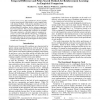1047 search results - page 54 / 210 » Learning the required number of agents for complex tasks |
AAAI
1994
13 years 9 months ago
1994
We describe a method for learning formulas in firstorder logic using a brute-force, smallest-first search. The method is exceedingly simple. It generates all irreducible well-form...
IWANN
2005
Springer
14 years 1 months ago
2005
Springer
A large class of problems requires real-time processing of complex temporal inputs in real-time. These are difficult tasks for state-of-the-art techniques, since they require captu...
PKDD
2009
Springer
14 years 2 months ago
2009
Springer
Abstract. Inverse reinforcement learning addresses the general problem of recovering a reward function from samples of a policy provided by an expert/demonstrator. In this paper, w...
AAAI
2007
13 years 10 months ago
2007
Reinforcement learning (RL) methods have become popular in recent years because of their ability to solve complex tasks with minimal feedback. Both genetic algorithms (GAs) and te...
AGENTS
1997
Springer
13 years 12 months ago
1997
Springer
Abstract. We present a purely vision-based scheme for learning a topological representation of an open environment. The system represents selected places by local views of the surr...

